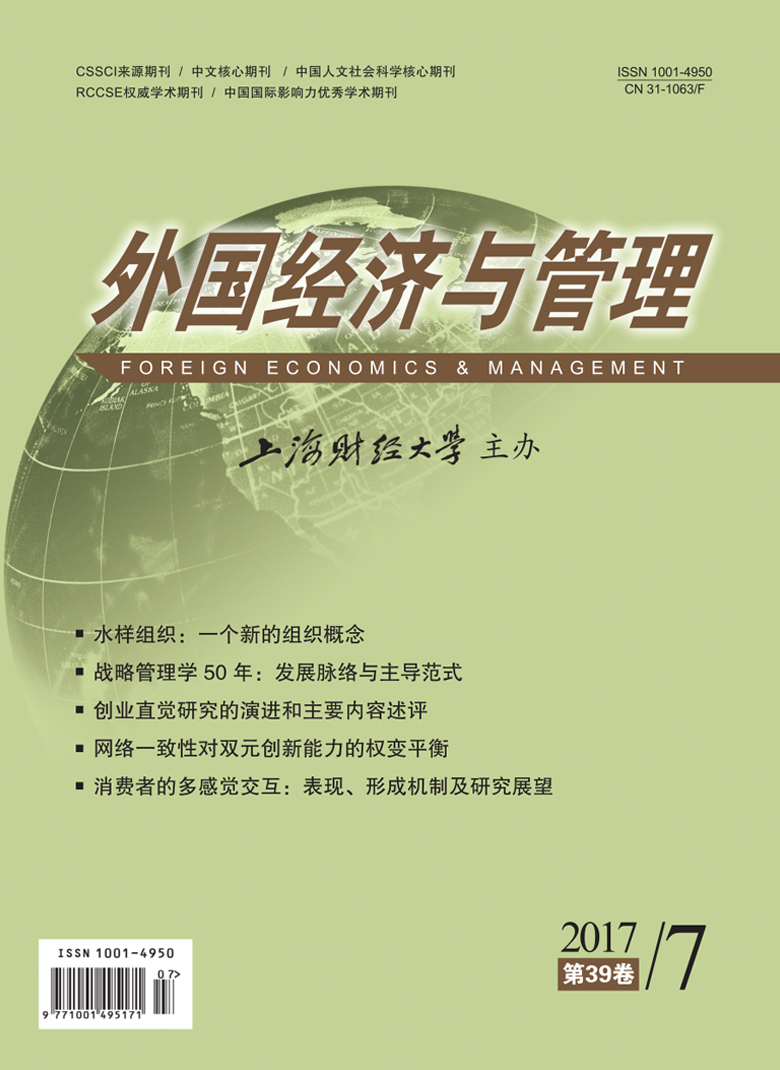如何平衡部门内探索式创新和利用式创新(双元创新)的矛盾,是管理实践和理论研究关注的重要主题。本文基于并行结构视角,运用社会网络理论和知识管理理论,分析了正式网络与非正式网络一致性对双元创新能力中探索式和利用式创新矛盾的平衡,并探讨了不同知识管理的调节作用。通过收集高新技术企业创新相关部门的实证数据进行分析,研究结果表明:部门正式互动或顺序工作流网络与非正式咨询网络的一致性与双元创新能力之间呈倒U型关系;知识交换与整合和知识冲突正向调节部门正式互动工作流网络与非正式咨询网络一致性与双元创新能力之间呈倒U型关系。说明适度重叠的部门正式互动或顺序工作流网络与非正式咨询网络能够有效平衡双元创新能力的矛盾,有效的知识管理能增强这一效果。该结论从社会网络视角细化了部门中并行结构自下而上实现双元创新能力的路径,并基于知识管理理论界定了并行结构实现双元创新的权变条件,也对企业借助正式与非正式网络一致性平衡探索与利用式创新的矛盾并形成双元创新能力具有重要指导意义。
网络一致性对双元创新能力的权变平衡
摘要
参考文献
摘要
关键词
3 吴绍波, 顾新. 知识网络节点组织之间的知识冲突研究[J]. 情报杂志, 2011,(12): 125–128. DOI:10.3969/j.issn.1002-1965.2011.12.023
6 Aalbers R, Dolfsma W, Koppius O. Rich ties and innovative knowledge transfer within a firm[J]. British Journal of Management, 2014, 25(4): 833–848. DOI:10.1111/bjom.2014.25.issue-4
7 Adler P S, Goldoftas B, Levine D I. Flexibility versus efficiency? A case study of model changeovers in the Toyota production system[J]. Organization Science, 1999, 10(1): 43–68. DOI:10.1287/orsc.10.1.43
8 Benner M J, Tushman M L. Exploitation, exploration, and process management: The productivity dilemma revisited[J]. Academy of Management Review, 2003, 28(2): 238–256.
9 Brennecke J, Rank O N. The interplay between formal project memberships and informal advice seeking in knowledge-intensive firms: A multilevel network approach[J]. Social Networks, 2016, 44: 307–318. DOI:10.1016/j.socnet.2015.02.004
10 Carmeli A, Azeroual B. How relational capital and knowledge combination capability enhance the performance of work units in a high technology industry[J]. Strategic Entrepreneurship Journal, 2009, 3(1): 85–103. DOI:10.1002/sej.v3:1
11 Gibson C B, Birkinshaw J. The antecedents, consequences, and mediating role of organizational ambidexterity[J]. Academy of Management Journal, 2004, 47(2): 209–226. DOI:10.2307/20159573
12 Gilbert C G. Change in the presence of residual fit: Can competing frames coexist?[J]. Organization Science, 2006, 17(1): 150–167. DOI:10.1287/orsc.1050.0160
13 Gulati R, Puranam P. Renewal through reorganization: The value of inconsistencies between formal and informal organization[J]. Organization Science, 2009, 20(2): 422–440. DOI:10.1287/orsc.1090.0421
14 He Z L, Wong P K. Exploration vs. exploitation: An empirical test of the ambidexterity hypothesis[J]. Organization Science, 2004, 15(4): 481–494. DOI:10.1287/orsc.1040.0078
15 Jansen J J P, Tempelaar M P, Van den Bosch F A J, et al. Structural differentiation and ambidexterity: The mediating role of integration mechanisms[J]. Organization Science, 2009, 20(4): 797–811. DOI:10.1287/orsc.1080.0415
16 Lavie D, Rosenkopf L. Balancing exploration and exploitation in alliance formation[J]. Academy of Management Journal, 2006, 49(4): 797–818. DOI:10.5465/AMJ.2006.22083085
17 Lomi A, Lusher D, Pattison P E, et al. The focused organization of advice relations: A study in boundary crossing[J]. Organization Science, 2013, 25(2): 438–457.
18 McDermott R, Archibald D. Harnessing your staff’s informal networks[J]. Harvard Business Review, 2010, 88(3): 82–89.
19 McEvily B, Soda G, Tortoriello M. More formally: Rediscovering the missing link between formal organization and informal social structure[J]. The Academy of Management Annals, 2014, 8(1): 299–345. DOI:10.1080/19416520.2014.885252
20 McFadyen M A, Semadeni M, Cannella Jr A A. Value of strong ties to disconnected others: Examining knowledge creation in biomedicine[J]. Organization Science, 2009, 20(3): 552–564. DOI:10.1287/orsc.1080.0388
21 Monks K, Conway E, Fu N, et al. Enhancing knowledge exchange and combination through HR practices: Reflexivity as a translation process[J]. Human Resource Management Journal, 2016, 26(3): 304–320. DOI:10.1111/hrmj.v26.3
22 O’Reilly C A, Tushman M L. Organizational ambidexterity in action: How managers explore and exploit[J]. California Management Review, 2011, 53(4): 5–22. DOI:10.1525/cmr.2011.53.4.5
23 Prieto I M, Pilar Pérez Santana M. Building ambidexterity: The role of human resource practices in the performance of firms from Spain[J]. Human Resource Management, 2012, 51(2): 189–211. DOI:10.1002/hrm.v51.2
24 Raisch S, Birkinshaw J. Organizational ambidexterity: Antecedents, outcomes, and moderators[J]. Journal of Management, 2008, 34(3): 375–409. DOI:10.1177/0149206308316058
25 Rank O N, Robins G L, Pattison P E. Structural logic of intraorganizational networks[J]. Organization Science, 2010, 21(3): 745–764. DOI:10.1287/orsc.1090.0450
26 Soda G, Zaheer A. A network perspective on organizational architecture: Performance effects of the interplay of formal and informal organization[J]. Strategic Management Journal, 2012, 33(6): 751–771. DOI:10.1002/smj.1966
27 Zappa P, Robins G. Organizational learning across multi-level networks[J]. Social Networks, 2016, 44: 295–306. DOI:10.1016/j.socnet.2015.03.003
引用本文
吕鸿江, 付正茂, 王道金, 等. 网络一致性对双元创新能力的权变平衡[J]. 外国经济与管理, 2017, 39(7): 65–79.
导出参考文献,格式为:





 , 1
, 1 8870
8870  9609
9609

